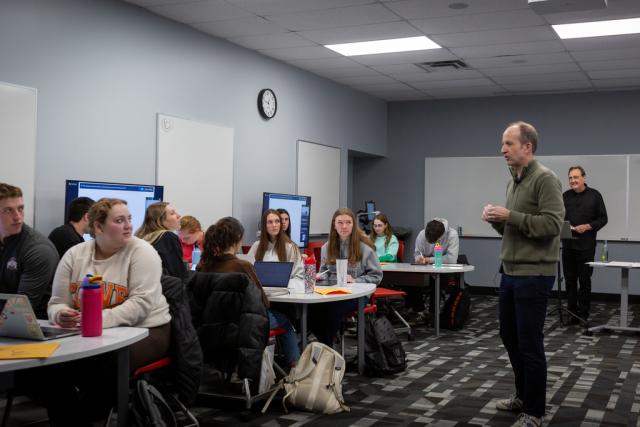At the Michael V. Drake Institute for Teaching and Learning and across The Ohio State University, we value diversity and inclusion for teachers and students. We strive to provide resources and support that foster inclusive learning environments for our community, both on campus and online.
What is Inclusive Teaching?
Inclusive teaching describes the range of approaches to teaching that consider the diverse needs and backgrounds of all students to create a learning environment where all students feel valued and where all students have equal access to learn. Incorporating inclusive teaching practices creates a learning environment where:
- Teachers develop supportive relationships with students.
- Teachers decrease the potential for incivility and unproductive conflict.
- Student participation and engagement increases.
- Students are more likely to take intellectual risks, persist with difficult material and retain learning across contexts.
These additional resources may be of particular interest:
Defining respect in the classroom
Why do we need to define respect?
A key way to create an inclusive classroom is to establish a set of community norms (Tanner 2017). This can take the form of a syllabus statement or a spoken assertion made on the first day of class and repeated throughout the semester. Often, the language “Treat other students and the instructor with respect” appears in this context.

Unsurprisingly, students and instructors may enter the classroom with different understandings of respectful behavior. Simply calling for “respect” leaves expectations vague, and may not prove sturdy enough for students and instructors to fall back upon during heated moments later in the semester. Defining respect at the beginning of the semester in terms of specific classroom behaviors can help ensure a shared understanding of expectations and provide a point of reference for managing conflict when it does arise (Ambrose et al. 2010; Bain 2004).
NEW RESOURCE: A collaboration between the Office of Diversity and Inclusion and the Drake Institute, this respectful dialogue toolkit defines respectful dialogue, identifies goals for faculty, staff and students, provides strategies, and shares additional resources and supports.
Sample definitions of respect
Here is a “menu” of possible classroom behaviors that you can use to define respect for your students. Not all will apply to every class; choose, add, or refine the elements that contribute to the learning environment you are trying to create.
- Use “I” statements about your own experience rather than sharing generalizations about groups.
- Critique ideas, not people.
- Honor the diversity that exists between and within groups of people.
- Use evidence to support your assertions. In this class, acceptable evidence includes […].
- Maintain a problem-solving orientation so that when problems arise, we assume we can work together to solve them.
- Listen carefully — When someone has the floor, give them the time and space they need to express themselves. Respectful participation means:
- Don't talk too much — try to recognize when your opinion is dominating the room and preventing you from listening to others. Share airtime.
- Don't talk too little — your perspective enriches us all. When you don’t participate, you rob your peers from hearing your side and rob yourself of feedback you might get from others.
- Beyond Talking — I will provide multiple ways to participate in addition to verbal discussions.
Please engage with in-class activities with an open mind — this course uses multiple types of activities across the semester including group work, discussions and interactive lecture. When the day’s activity is not your preferred way to engage, know that for others in the room, this is their favorite way to learn and you will have other days where your preferences are prioritized.
The importance of follow-through
Once you have formulated a definition of respect for your classroom, include it in your syllabus and/or discuss it with your students during the first few class sessions. Then, be sure to remind students of these community norms frequently throughout the semester, and especially before a difficult discussion.
If a student acts in a disrespectful way, call it out and remind the class of the expectations you set at the beginning of the term. If another student has been attacked or made uncomfortable, publicly reassure that student and emphasize the value of their contributions to class. Students will observe whether you enforce the norms, and this will shape their subsequent behavior. (For more, see How to Deal with Hurtful Speech in the Moment)
References:
Ambrose, S. A., Bridges, M.W., DiPietro, M. & Lovett, M.C. (2010). How learning works: Seven research-based principles for smart teaching. San Francisco, CA: Jossey Bass.
Bain, Ken. (2004). What the best college teachers do. Cambridge, MA: Harvard.
Tanner, Kimberly D. (2013). “Structure Matters: Twenty-One Teaching Strategies to Promote Student Engagement and Cultivate Classroom Equity.” CBE – Life Sciences Education, 12(3), 322-331.
Teaching for racial justice
As a part of our stated mission to be “an exemplar of teaching excellence… to improve student success,” the Michael V. Drake Institute for Teaching and Learning is deeply committed to providing instructors with resources that support anti-racist pedagogies.
Conversations around police brutality, racialized violence and institutional racism have come to the fore in recent months, and thoughtful management of these conversations will be more critical than ever as we return to campus this fall. We hope you will find these collected tips and resources valuable as you productively navigate these conversations in your classroom.
As always, Drake Institute consultants are available to work with you and/or your department to address these issues, and any other issues that may be shaping the teaching and learning environment in which we collectively strive for inclusive excellence.
Tips for Navigating Conversations
Address problematic remarks immediately and directly: If a student makes a remark that you or anyone in the classroom considers to be problematic, be sure to take the time to address and explore it directly. By doing so, you will model accountable behavior and remove responsibility for clarifying and correcting inappropriate commentary from minoritized students.
Call In rather than Call Out: Calling out is an act of pointing out that another person is participating in an oppressive action. In contrast, Calling in is a deliberately compassionate practice of pulling folks back in when they stray from the group.
Make boundaries clear to students ahead of conversation: Build up to potentially challenging conversations by clarifying language and etiquette with your students. Consider creating a classroom contract and/or discussion guidelines with students to guide them through these discussions.
Redirect rather than challenge comments: Pull the positive intentions out of what might be well-meaning but awkwardly worded comments. Help students to rephrase their statements more respectfully.
Focus on group and community learning: Rather than confronting an individual student for their comments, turn the focus to group and community accountability. Remind students of any classroom commitments or guidelines they have agreed to, and to be respectful to others present.
Related resources:
- Counseling and Consultation Service (opens in new window)
- Office of Diversity and Inclusion (opens in new window)
- The Kirwan Institute (opens in new window)
Shaping inclusion

As the teacher, you have a great deal of agency in shaping inclusion within your courses. The identity and reflection you bring to the course, the choices you make about content and teaching strategies, the expectations you set and rapport you build are all powerful tools. We encourage each teacher at Ohio State to create inclusive classrooms through proactive planning before the semester begins.
It is also often the case that we find ourselves responding in the moment to conflict or incidents where inclusive teaching strategies are necessary.
Here are some core strategies for incorporating inclusive practices in your teaching when planning a course and when responding to incidents.
Planning an Inclusive Course
- Create a welcoming, respectful learning environment
- Get to know your students
- Set explicit expectations for civil discourse
- Model inclusive language on your syllabus and during classroom interactions
In addition, you can:
- Use teaching methods that consider diverse learning preferences, abilities, ways of knowing, and prior experience and knowledge.
- Use multiple teaching strategies that allow students to access the content and demonstrate their learning in more than one way.
- Don’t conflate writing ability with thinking ability
- Incorporate texts and perspectives that help a wide variety of students connect to the content
- Promote respectful interaction among students and between you and the students
- Respond to conflict or incivility
- Plan for controversial topics
- Collect feedback from students at multiple points during the semester
Responding to Conflict or Incivility
This is not a problem that can be solved with quick tips: if you are experiencing teaching-related conflict or classroom incivility that you need help addressing, please contact the Drake Institute for a personal consultation.
When tempers flare or controversial topics are raised, classroom conflicts can disrupt your learning environment and make students feel confused, anxious or unsafe. Learning is a messy, sometimes emotional, process. Just as we expect to see mistakes and opportunities for growth in writing or problem solving, it’s developmentally normal for students to need practice exploring emotional ideas and challenging their perspectives before they can grow as critical thinkers. Critical incidents can become powerful learning experiences when teachers are prepared to handle the situation:
- Have a plan before teaching controversial topics to minimize conflict.
- Learn more about stereotype threat and why responding to incivility matters.
- When unexpected conflict occurs, acknowledge the situation and respond.
It is not always possible to prevent incivility, micro-aggressions or outright conflict from entering our classrooms. There are many acceptable approaches for responding to these classroom conflicts. Being prepared with one or two responses can help you regain control of the classroom when emotions are running high.
- Slow things down with writing
- Stop everything to restate your expectations for respectful behavior
- Use the Open The Front Door strategies to model for students a way to process and move forward
Remember: responding to an incident after the fact is still better than ignoring it completely. If you have experienced a conflict that you were unprepared to handle, you can return to the classroom in the following lesson and describe what happened, why it is a problem and what your expectations are.